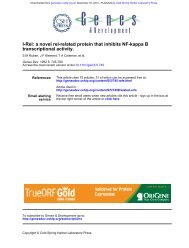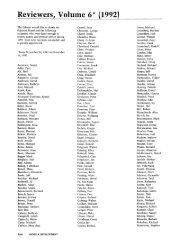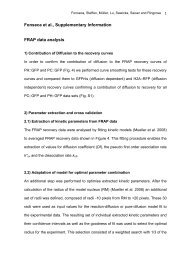Pancreatic cancers require autophagy for tumor growth - Genes ...
Pancreatic cancers require autophagy for tumor growth - Genes ...
Pancreatic cancers require autophagy for tumor growth - Genes ...
You also want an ePaper? Increase the reach of your titles
YUMPU automatically turns print PDFs into web optimized ePapers that Google loves.
Downloaded from<br />
genesdev.cshlp.org on June 4, 2013 - Published by Cold Spring Harbor Laboratory Press<br />
comet assays revealed increased tail moments in CQtreated<br />
cells (Fig. 6C), confirming the presence of increased<br />
DSBs. These effects were mitigated by concurrent<br />
treatment with NAC, demonstrating that they are mediated<br />
by ROS (Fig. 6A,B). Importantly, NAC also partially<br />
rescued cell proliferation and clonogenic <strong>growth</strong> of the<br />
CQ or ATG5 siRNA-treated cells (Fig. 6D,E). Together,<br />
these data demonstrate that <strong>autophagy</strong> serves to control<br />
ROS levels and, ultimately, DNA damage in PDAC cells,<br />
allowing <strong>for</strong> continued <strong>tumor</strong> <strong>growth</strong>.<br />
We speculated that the increased mitochondrial ROS<br />
seen with <strong>autophagy</strong> inhibition by CQ and RNAi may<br />
arise from impairment in mitochondrial function. As<br />
<strong>autophagy</strong> has a known role in mitochondrial quality<br />
control by degrading damaged mitochondria (Priault et al.<br />
2005), we assessed whether inhibition of <strong>autophagy</strong> leads<br />
to a decrease in mitochondrial function. To this end, we<br />
measured the effect of either CQ treatment or shRNAs to<br />
ATG5 on oxidative phosphorylation in 8988T PDAC<br />
cells. As shown in Figure 7A, oxygen consumption was<br />
severely decreased upon CQ treatment. Consistent with<br />
these data, inhibition of <strong>autophagy</strong> using shRNAs to<br />
ATG5 also decreased oxygen consumption (Fig. 7B).<br />
There<strong>for</strong>e, <strong>autophagy</strong> inhibition in PDAC cells leads to<br />
a decrease in oxidative phosphorylation. Consistent with<br />
the decrease in oxidative phosphorylation was that CQ<br />
treatment of these cells caused a significantly elevated<br />
<strong>Pancreatic</strong> <strong>cancers</strong> <strong>require</strong> <strong>autophagy</strong><br />
Figure 3. Inhibition of <strong>autophagy</strong> in<br />
PDAC cell lines attenuates <strong>growth</strong> and<br />
<strong>tumor</strong>igenicity in vitro. (A) Growth curves<br />
of four different PDAC cell lines (8988T,<br />
BXPC3, 8902, and Panc1) and control cell<br />
lines H460 and MCF7 treated with CQ<br />
(6.25 mM and 12.5 mM) to inhibit <strong>autophagy</strong><br />
or with PBS as a control. The PDAC cells<br />
showed a dose-dependent robust suppression<br />
of <strong>growth</strong>, whereas H460 and MCF7<br />
cells with low basal <strong>autophagy</strong> were only<br />
minimally affected. (B) IC50 of CQ in<br />
micromolar in a panel of PDAC lines and<br />
H460 and MCF7 cells. Note the low IC50<br />
values <strong>for</strong> the PDAC lines as compared<br />
with MCF7 and H460. (C) Soft agar assays<br />
were per<strong>for</strong>med to assess <strong>for</strong> the ability of<br />
CQ (10 mM) to inhibit anchorage-independent<br />
<strong>growth</strong>. Colony <strong>for</strong>mation was suppressed<br />
in 8988T and Panc1 cells, but not<br />
MCF7 and H460 cells. The histogram below<br />
shows quantitation of these assays<br />
relative to untreated cells. Error bars represent<br />
triplicates. (D) Bafilomycin A1, an<br />
inhibitor of lysosomal acidication and<br />
<strong>autophagy</strong>, attenuates PDAC anchorageindependent<br />
<strong>growth</strong>. Cells were seeded in<br />
soft agar and treated with 5 nM bafilomycin<br />
A1 (charcoal bar) or vehicle (light-gray bar).<br />
Data are expressed relative to control, with<br />
error bars representing standard deviations<br />
of triplicates. Note the robust reduction in<br />
Panc1 and 8988T PDAC cells but not in<br />
H460 and MCF7 cells.<br />
uptake of glucose and production of lactate (Fig. 7C),<br />
indicating that there was a compensatory switch to<br />
glycolysis in response to impaired oxidative phosphorylation.<br />
Importantly, these cells show a significant decrease<br />
in intracellular ATP (Fig. 7D) upon <strong>autophagy</strong><br />
inhibition, likely reflecting the inability of these cells to<br />
maintain normal energy production.<br />
The reduction in oxidative phosphorylation could reflect<br />
an accumulation of damaged mitochondria due to<br />
suppression of mitophagy (the autophagic degradation of<br />
mitochondria). However, we were unable to demonstrate<br />
significant basal mitophagy in PDAC cells even in the<br />
presence of CQ (Supplemental Fig. 3A; data not shown).<br />
Consistent with these findings, there did not appear to<br />
be a significant increase in mitochondrial mass upon<br />
<strong>autophagy</strong> inhibition by CQ treatment (Fig. 7E). Additionally,<br />
as damaged (depolarized) mitochondria are typically<br />
targeted <strong>for</strong> mitophagy (Twig et al. 2008), we next<br />
assessed mitochondrial membrane potential in PDAC<br />
cells upon <strong>autophagy</strong> inhibition. As shown in Figure 7F,<br />
there was no significant increase in membrane depolarization<br />
upon <strong>autophagy</strong> inhibition. Together, these data<br />
suggest that the mitochondria themselves are functional,<br />
and that the decrease in oxidative phosphorylation may<br />
reflect a decrease in carbon substrates that fuel the TCA<br />
cycle. To determine if this was indeed the case, we attempted<br />
to rescue the effect of inhibiting <strong>autophagy</strong> in<br />
GENES & DEVELOPMENT 721







